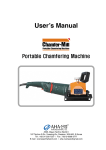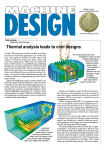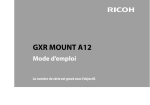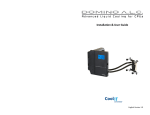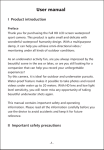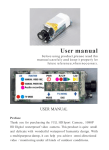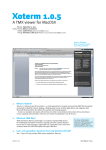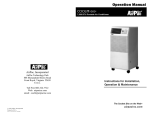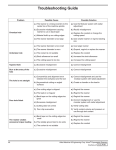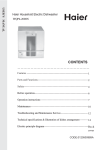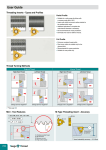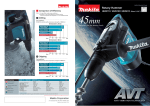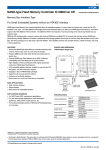Download User Guide - euro issa company
Transcript
User Guide Sealed Collet Application ER collets are used for applications requiring through coolant, as well as for standard cutting tools such as drills, boring bars, end mills, reamers, taps and special tools. They provide an effective solution for accurate controled coolant flow. Front sealing collets are available for advanced high speed machines with through coolant spindles/turrets. They provide maximum performance, high cutting speeds, extended tool life and high quality surface finish. Features • • • • • • A revolutionary high precision front sealing collet with 1.00mm collapsibility that has through coolant capability Increased machining efficiency Extended tool life Has powerful gripping and parallel clamping Front sealing provides protection from contamination Fast chip removal from work piece Advantages • High-pressure coolant supply up to 100 bar • Eliminates coolant flow interference Notes • For maximum security and clamping power, the cutting tool shank must be inserted into the collet to a minimum depth of 2 X shank diameter • In sealed collet JET2 the nozzle must be adjusted directly to the flute of the cutting tool • Suitable for all shank standards TaeguTec ER Coolit Sealed Collet Two types: Sealed collet jet 2 Sealed collet jet For straight shank cutting tools with internal coolant supply Shank Standards Plain Shank WELDON/DIN 1835/B Whistle Notch G86 With angular double nozzle. Coolant flow is direct to the cutting edge - for use with standard straight shank cutting tools (without coolant hole) User Guide ER - Top Clamping Nut DIN 6499 Description The friction ER Nut has a unique two piece exclusive friction mechanism combining radial and angular self-centering movements. Features Unique two piece friction bearing Radial and angular float for better concentricity. Powerful gripping force, 50-100% higher than standard ER nut due to the friction bearing mechanism Balanced for higher spindle speed due to unique extractor teeth design Compact design - general dimensions and size range are the same as the standard nut Sealed design for use with sealed collets Operation To insert collet: Always assemble the collet into the nut before mounting onto the collet chuck. Inserting Procedure Insert the collet slantwise, fitting the two protruding extractor teeth (A) into the collet groove (B). Place the two parts onto a clean and horizontal surface. Press down with your thumb on the back end of the collet until it clicks into place (C). B A A C Collet Groove Extractor Teeth Important Never insert the collet parallel to the extractor ring. This will chip or break the teeth of the extractor. When unclamping the nut, the collet will self release from the chuck by means of the extractor teeth. Extracting Procedure 1. Align the diamond-shaped engraved logo which is on the silver ring (D) to any of the key slots (E) of the nut. 2. Place the nut with the collet facing down on a clean and horizontal work surface. 3. Insert a screwdriver vertically between the nut slots and the collet – on the reverse side of the diamond shaped engraved logo (D). 4. Tilt the screwdriver outwards while helping the extraction by pushing the back of the collet in the opposite direction (F). F E D Note: For maximum performance the clamping nut thread and collet taper must be cleaned and oiled before use. Recommended Clamping Torque for Standard ER & ER-Top Clamping Nut Nut type ER-11 ER-11M ER-16 ER-16M ER-20 ER-20M ER-25 ER-32 ER-40 ER-50 Kg × m 5 3 7 4 12 8 20 22 25 35 Important: The torque is calculated to suit the maximum diameter capacity of each collet. The torque should be gradually reduced when used with a smaller shank size. G87 User Guide TSK Slim Collet Chuck Features & Advantages • Excellent accuracy & good gripping power by gentle taper angle (ER collet : 8º, TSK collet : 4º) • Slim design for deep and cavity machining • Suitable on high speed machining • Variety of TSK collets (normal & coolant type) • General machining using drill & end mill Application • General machining using drill & end mill • High speed machining for Mold & Die industry • Accurate machining using reamer & end mill How to assemble the collet with a nut a. Assembly Device (provided with the set) Insert the back end of the collet (c) into the assembly device (a) b. Nut ❷ Insert the combined part (a+c) in the nut (b) c. Collet ❸ Pluck out the assembly device (a) from the remaining part (b+c) Quick-Change System DIN 69871 HSK BT MAS 403 Advantages • • • • • Taper and face contact Ideal for High Speed Machining High precision – low runout Excellent rigidity Quick and easy clamping Quick-Change Advantages • Quick tool change - The taper shank and the holder connect • • • • • • in a quick half turn. No thermal shock on holder taper Flexibility in diameter and length Eliminates the use of extension chuck No spare parts required T-CLICK blanks available to provide custom made tooling Shrink clamping for solid carbide tooling Tightening torque: 235N.m G88 User Guide Balanceable Collet Chuck System • Direct reading precision rings for high grade balance DIN 69871 HSK BT MAS 403 • Simple procedure on all types of balancing machines • Static and dynamic balance Balancing Elements Introduction Balancing is the process of ensuring the mass distributed by a body rotates on its axis without unbalance centrifugal force. Balancing reduces the risks of vibration, ensures lower strain on machine tool spindle, permits higher cutting data, extends tool life and improves machining conditions. Available measuring equipment enables unbalance to be reduced to minimal amounts. However, it would be uneconomical to exaggerate the quality requirements. It has therefore become necessary to determine to what extent the unbalance should be reduced, and where the optimum economic and technical compromise on balance quality requirements would be struck. Definition G - Balance quality (mm/s) e - Specific unbalance (g × mm/kg) Ω - Speed (rad/s) N - Speed (rpm) e= U =>U=M×e M M- Mass of the body (kg) m- Mass of the unbalance (g) r - Radius of the unbalance (mm) U - Residual unbalance (g × mm) Ω = 2π N = π N 30 60 Operation Residual unbalance equals the tool’s mass (M) multiplied by its eccentricity (e). Eccentricity measures the extent to which the tool’s weight is off-center. It is defined as the distance from the tool’s center of the rotation to its true center of mass. Balancing Elements Eccentricity is measured in microns and tool mass is measured in kilograms. The units yield a residual unbalance in gram-millimetres. Any two sets of mass and eccentricity that yield the same unbalance value will have the same effect on the tool, so long as the residual unbalance is in the same plane perpendicular to the rotation axis. U=r×m The residual unbalance is independent of the speed. This value reflects the unbalance mass and its distance from the true center of mass. The residual unbalance value is measured on balancing machines. G89 User Guide Features & Advantages • Consistent gripping force • Excellent Accuracy (run-out : within 5㎛) • Convenient and safe tool change using a clamping screw • Can use THC straight collets (normal & coolant type) Application • Accurate machining – fine milling – reaming – fine boring • Drilling – small diameter using carbide drill – for Al or cast iron Operation • Tool Mounting - Insert the tool shank between Lmax and Lmin (Fig 1) and then, turn the clamping screw clockwise until it can no longer rotate • Tool Releasing - To release the tool from the hydraulic chuck, turn the clamping screw in a counter clock-wise direction approximately 5 or 6 evolutions and remove the tool shank • Notice - Eliminate grease, coolant oil and any dirt from the internal bore of the Hydraulic chuck and tool shank prior to mounting - Ensure the minimum chucking length (L min) is maintained (see fig 1 & table 1) - Cylindrical tool shanks available in accordance with h6 tolerance (table 2) and Ra min =0.3㎛ (ground) and Weldon shanks should be used in collet only - Remove the end tool from the hydraulic chuck when not in use for long periods of time - Do not turn the clamping screw prior to tool mounting in the hydraulic chuck *Please refer to the backface for information tables. Figure 1. Tool structure Table 1. recommended minimum & maximum depth (L) of end tool insertion G90 Inner bore diameter Ø(mm) L min (mm) L max (mm) 6 27.5 37.5 8 27.5 37.5 10 32.5 42.5 12 37.5 47.5 14 37.5 47.5 16 42.5 52.5 20 42.5 52.5 25 51 61 32 55 65 Table 2. h6 tolerance range Shank size Ø(mm) 3 3 6 6 10 10 18 18 30 30 50 h6 tolerance range(㎛) 0 -6 0 -8 0 -9 0 -11 0 -13 0 -16 Table 3. clamping torque Inner bore diameter Ø(mm) Calmping torque(N*m) 6 10 8 25 10 40 12 65 14 90 16 120 20 240 25 260 32 450 User Guide Thermal Chucking System Chucking System The thermal T-Shrink ER Collet Chucking System is an enhancement to the existing popular ER system. The T-Shrink collets utilize the thermal shrink phenomena for rigid clamping of solid carbide cutters. This new system provides higher torque, precision runout and better repeatability. The T-Shrink Collets with their slim design and different projection length allows the user to reach into deeper cavities and perform narrow milling applications. TaeguTec offers a complete system for T-Shrink ER Collets, including a uniquely designed heating unit with a portable heating handle. The unit is equipped with a high-tech temperature control for easy and practical use at the machining center or in the tool room. For carbide tools only L(mm) • • • • • • • • • • • 357µm 609µm 85 Features Max T.I.R 10µm Slim design to maximise effectiveness and application access Flexible - fits into standard ER chucks High torque transfer Rigid clamping of carbide tools High precision – low runout Perfect repeatability Vibration damping Coolant JET2 available Symmetrical design for High Speed Machining Quick and easy tool changing Unique T-Shrink heating unit with portable handle 0.003mm Clamping time 15~45 sec G91 User Guide DIN 69871 T-Short ER32 New short holder for ER32 spring and shrink collets for maximun rigidity and improved cutting conditions HSK DIN 69893 BT MAS-403 Advantages Short overhang Suitable for T-short and T-shrink collets • High gripping force • Reduces vibration • Improved runout and repeatability • Balanced to G2.5, 20,000 rpm • Symmetrical design for High Speed Machining • Cost effective • • G92 User Guide GTI-Tap Attachment Description Short tap chucks for ER collets Application Axial-float/tension/compression type for CNC milling machines and lathes with reversing motors and rigid tap ping Features • Compensates for machine feed and tap pitch variance • Floating mechanism compensates for misalignment between tap and workpiece • Right and left-hand tapping Advantages • Practical and efficient tap holding by the ER spring collet without using drive jaw • Compact design for minimal clearance applications • Heavy-duty design for high torque drive ensures the same accuracy as the tap itself DIN 69871 BT MAS-403 Straight Shank Operation For through and blind hole tapping: 1 Enter feed rate according to thread pitch (or 1-2% lower), and set spindle to starting point with 0.08mm clearance. 2 Start spindle forward 3 Stop feed and rotation with right hand rotation until reaching desired depth. and reverse to starting point. / Holder for Adjustable Drilling Diameter Adjustable Rotary Tool Holder Indexable Insert Drills Application • For use on machining centres and drilling machines Features • • • • Diameter adjustment range – 0.30mm to +1.30mm Guaranteed bore tolerance of ±0.02mm Through the shank coolant design or “Type B” coolant through the flange Coolant pressure up to 70 bar Min: D-0.3 Max: D+1.3 Operation Best results are achieved on a preset machine or similar device. A B 1. To adjust the offset - slacken clamp screw A 2. Adjust with screw B and set to minus 0.20mm below required diameter 3. Tighten clamp screw A 4. Take a trial cut and measure the bore diameter 5. Adjust to suit requirements 6. Final adjustment can be made on the machine using a dial indicator or on a presentable G93 User Guide GYRO - Radial and Angular Alignment of Tool Holder Advantages • Easy adjustment for correcting misalignment between chuck and turret axis (drill and workpiece) • Precise and efficient tool clamping with ER collets and ER sealed Coolit Jet collets • Quick functional adjustment is made on machine by using plug and ring gauge kit Operation Operating instructions are provide with each tool supplied. Notes • Coolant supply should be minimum 10 bar and maximum 80 bar for small diameter oil hole drills - ranging from 3~20mm. (the normal machine pressure of 4 bar is insufficient) • Coolant filtration is important to eliminate chips from blocking the drill oil hole • To ensure maximum performance of the GYRO, the backlash of the turret indexing and support axis mechanism should be checked and re-adjusted according to the machine standard GYRO - Radial and Angular Alignment of Tool Holder Adjustable Tool Holder for Easy Adjustment of Radial and Angular Misalignment Application Gyro is a rugged and adjustable toolholder to solve drilling, tapping and reaming problems encountered on CNC and turret lathes. Its unique design allows smooth and easy adjustment of radial and angular misalignment between chuck and turret. yro reduces total machining time by making it possible to complete machining of holes in one drilling step G and achieve tolerances as close as 0.01mm, thereby eliminating subsequent boring or reaming operations. • A breakthrough in drilling technology for CNC lathes • Dramatic increase in tool performance at reduced cost T.I.R. max 0.02mm Features • Enables high precision drilling to a close tolerance of 0.01mm, to be performed as a final boring operation on CNC lathes • Reduces machining cycle time by completing the bore in one drilling step, eliminating secondary turning and boring operations • Prolongs tool life tenfold, especially when using HSS, solid and brazed carbide drills, taps and reamers • Permits increase in speeds and feeds by up to 300% • Coolant supply through the centre of the unit via the tool shoulder for oil fed drilling Angular Adj. 1˚ TaeguTec GFI ER - Floating Reamer Collet Chuck Floating chuck adjusts the misalignment between reamer and workpiece hole to ensure the same accuracy as the reamer itself. Application The GFI floating chuck is a unique holder to compensate for the radial misalignment existing in the reaming operations carried out on vertical and horizontal machine tools. Features • Radial self floating mechanism compensates misalignment between reamer and workpiece to ensure the same tolerance as the reamer itself • The special self centering mechanism eliminates tapered and oversized bores Advantages • Unique ball bearing and axle drive shaft structure enables vertical and horizontal machining • Precise and efficient clamping with ER spring collets of ER Coolit collets G94 Radial Adj. 2.0mm User Guide Machining Center Shank Details 0 30° -15° 0 30° -15° 7/24 Taper L5 d g D1 d1 d2 b t t L4 7/24 Taper D4 D5 D6 d1 d2 b j D L2 V L3 y L1 X j X1 t1 30 40 45 50 Taper No 30 40 45 50 TaeguTec No MAS ISO ANSI DIN MAS ISO ANSI DIN MAS ISO ANSI DIN MAS ISO ANSI DIN TaeguTec No MAS ISO ANSI DIN MAS ISO ANSI DIN MAS ISO ANSI DIN MAS ISO ANSI DIN D1 31.75 Shank L4 31.75 44.45 44.45 44.45 44.45 57.15 57.15 57.15 57.15 69.85 69.85 69.85 69.85 48.4 ±0.2 t e  D4 0 44.7 -0.5 0 44.7 -0.5 50 max 0 -0.5 0 -0.5 57.4 57.4 63 max 0 -0.5 0 -0.5 70.1 70.1 80max d1 14 19 19.0max 18.5 19.0max 23 23.4max 22.5 23.4max 27 28.4max 26.5 28.0max d2 12.5 H8 44.3 -0.5 53 0 56.25-0.5 0 56.25-0.5 0 56.25-0.5 73 0 75.25-0.5 0 75.25-0.5 0 75.25-0.5 85 0 91.25-0.5 0 91.25-0.5 0 91.25-0.5 13 17 H8 17 H8 16.4 +0.4 0 17 H7 21 H8 21 H7 20.4 +0.4 0 21 H7 25 H8 25 H7 24.8 +0.4 0 25 H7 D5 46 H8 0 V y L1 X f Thread g L2 L3 M12 24min 34min M12×1.75 M16×2 M16×2 M16×2 M16×2 M20×2.5 M20×2.5 M20×2.5 M20×2.5 M24×3 M24×3 M24×3 M24×3 24min 30min 32min 30min 32min 38min 40min 38min 40min 45min 47min 45min 47min L4 7.0 +0.5 0 b 16.1 Taper L5 H12 t t1 0 17min 16.3 -0.2 j  38 45max 14 0 47.8 -0.3 65.4 ±0.2 0 68.4 -0.3 0 68.4 -0.3 0 68.4 -0.3 82.8 ±0.2 0 82.70 -0.3 0 82.7 -0.3 0 82.70 -0.3 101.8 ±0.2 0 101.75 -0.3 0 101.75 -0.3 0 101.75 -0.3 D3 L2 L3 • DIN 69871•  • ISO, ANSI • L1  D3 D4 D5 D6 D1 • MAS BT-403 • Taper No d g e f 20 0 50 -0.1 63 H8 0 63.55 -0.1 0 63.55 -0.1 0 63.55 -0.1 H8 85 0 82.55 -0.1 0 82.55 -0.1 0 82.55 -0.1 100 H8 0 97.50 -0.1 0 98.45 -0.1 0 97.50 -0.1 Flange 25 30 35 15.90 15.90 +0.1 15.90 0 15.90 15.90 +0.1 15.82 0 15.90 15.90 0 15.82 -0.1 15.90 33.5min 5.5 +0.5 0 43min 9.0 +0.5 0 42.5min 8.2 +0.5 0 4.75 +0.5 00 42.5min 8.2 +0.5 0 53min 11.0 +0.5 0 52.5min 10.0 +0.5 0 5.25 +0.5 0 52.5min 10.0 +0.5 0 62min 13.0 +0.5 0 61.5min 11.5 +0.5 0 5.75 +0.5 0 61.5min 11.5 +0.5 0 V X 13.6 ±.0.1 4 11.1 ±.0.1 16.6 ±.0.1 11.1 ±.0.1 11.1 ±.0.1 11.1 ±.0.1 21.2 ±.0.1 11.1 ±.0.1 11.1 ±.0.1 11.1 ±.0.1 23.2 ±.0.1 11.1 ±.0.1 11.1 ±.0.1 11.1 ±.0.1 3.75 0 5 +0.15 3.75 0 +0.15 3.75 0 +0.15 3.75 0 +0.15 6 0 +0.15 3.75 0 +0.15 3.75 0 +0.15 3.75 0 7 +0.15 3.75 0 +0.15 3.75 0 +0.15 3.75 0 16.1 H12 16.1 H12 16.1 H12 +0.2 16.1 16.1 H12 19.3 H12 19.3 H12 19.3 H12 +0.2 19.3 0 19.3 H12 25.7 H12 +0.2 25.7 0 25.7 H12 0 16.4 -0.4 0 21min 22.6 -0.2 0 22.8 -0.4 0 22.8 -0.4 0 16.4 -0.4 0 26min 29.1 -0.2 0 29.1 -0.4 0 29.1 -0.4 29 max 0 31min 35.5 -0.4 0 35.5 -0.4 0 35.5 -0.4 0 35.5 -0.4 y 8 +0.1 2 ±.0.4 17.633 8 3.2 ±.0.1 2 ±.0.4 3.2 ±.0.1 3.18 3.2 ±.0.1 3 ±.0.4 3.2 ±.0.1 3.18 3.2 ±.0.1 3 ±.0.4 3.2 ±.0.1 3.18 3.2 ±.0.1 17.808 25.375 24.500 24.500 24.500 33.000 33.029 33.029 33.029 40.158 40.173 40.173 40.173 7 10 7 7 7 12 7 7 7 15 7 7 7 10 +0.1 0 12 +0.1 0 15 +0.1 0 0 25.0 -0.4 0 26.0 -0.4 0 25.0 -0.4 0 31.3 -0.4 0 32.5 -0.4 0 31.3 -0.4 0 37.7 -0.4 0 40.4 -0.4 0 37.7 -0.4 d 0 -0.3 15 Reference X1 +0.15 d3 19 0 0 18.50 -0.3 0 18.5-0.3 0 24.00 -0.3 0 24 -0.3 0 30.00 -0.3 30 0 -0.3 D6 56.144 59.3 75.679 72.30 ±.0.05 72.30 ±.0.05 72.30 ±.0.05 100.216 91.35 ±.0.05 91.35 ±.0.05 91.35 ±.0.05 107.25 ±.0.05 107.25 ±.0.05 107.25 ±.0.05 107.25 ±.0.05 G95 User Guide MT Socket Details Taper No α° d g D h G96 L1 L2 z Taper Taper Angle (α˚) D d L1 L2 (Max) (Max) g h z MT0 1/19.212 0.05205 1˚ 29′ 27″ 9.045 6.7 52 49 4.1 15 1 MT1 1/20.047 0.04988 1˚ 25′ 43″ 12.065 9.7 56 52 5.4 19 1 MT2 1/20.020 0.04995 1˚ 25′ 50″ 17.780 14.9 67 62 6.6 22 1 MT3 1/19.922 0.05020 1˚ 26′ 16″ 23.825 20.2 84 78 8.2 27 1 MT4 1/19.254 0.05194 1˚ 29′ 15″ 31.267 26.5 107 98 12.2 32 1.5 MT5 1/19.002 0.05263 1˚ 30′ 26″ 44.399 38.2 135 125 16.2 38 1.5 MT6 1/19.180 0.05214 1˚ 29′ 36″ 63.348 54.6 188 177 19.3 47 2 MT7 1/19.231 0.05200 1˚ 29′ 22″ 83.058 71.1 258 241 28.8 69 2











